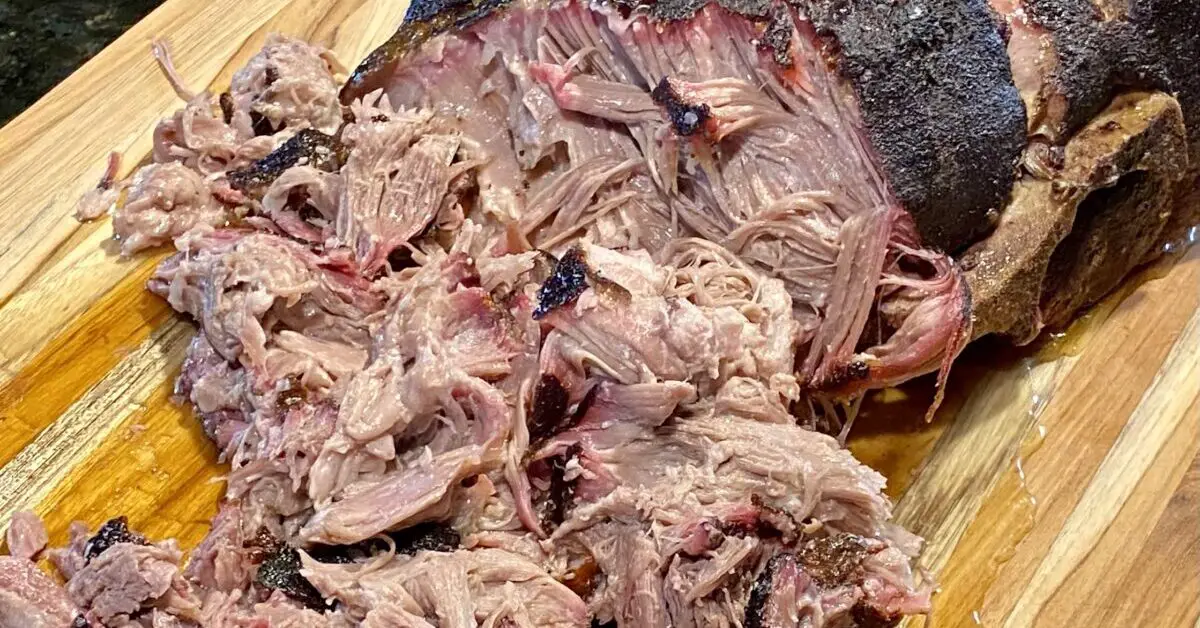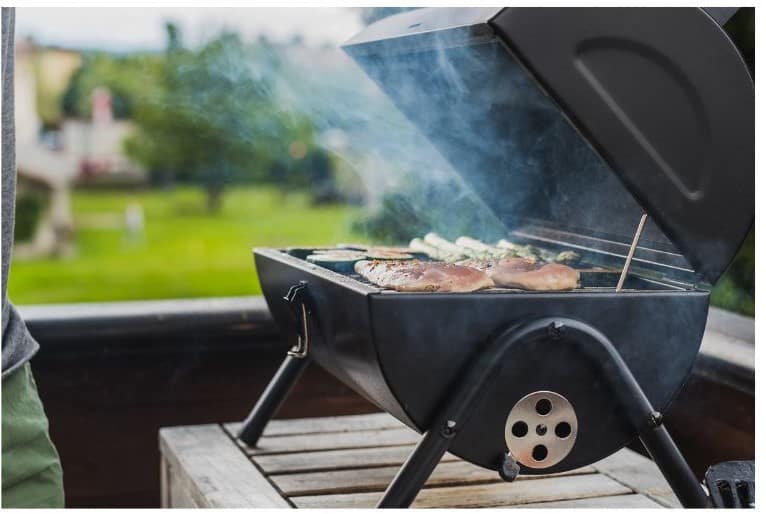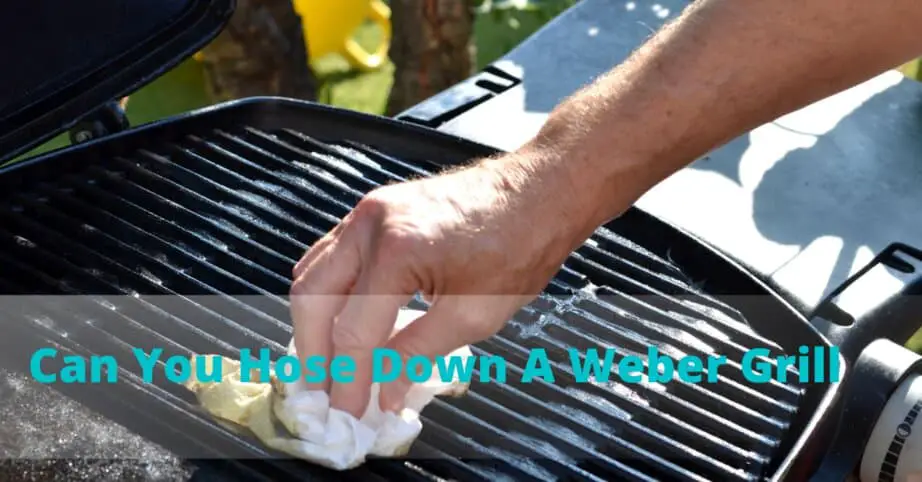To smoke a pork shoulder on a charcoal grill, first set up your grill for indirect heat and maintain a temperature of around 225-250 degrees Fahrenheit. Place the pork shoulder fat side up on the grate away from the coals and smoke until it reaches an internal temperature of 195-205 degrees Fahrenheit.
Preparing a pork shoulder for smoking on a charcoal grill can elevate your backyard barbecue to a gastronomic event. Smoking meat is an art that combines patience with technique to produce tender, flavorful results. A well-smoked pork shoulder, also known as a Boston butt or picnic roast, becomes the foundation for a variety of mouth-watering dishes.
From succulent pulled pork to savory slices, the key lies in maintaining a consistent low heat and giving the meat ample time to develop complexity. With the right preparation and a watchful eye on the temperature, even novice grillers can achieve that coveted smoky flavor and perfect bark that are the hallmarks of great barbecue.
Selecting The Perfect Pork Shoulder
Smoking a pork shoulder on a charcoal grill unleashes flavors that are tough to top. The key to a mouth-watering feast starts with selecting the right pork shoulder. It’s a process that involves understanding cuts and meat grades. Let’s dive into choosing the best pork shoulder, ensuring your barbecue is nothing short of legendary.
Picking The Right Cut
Two primary cuts come from the shoulder of a pig: ‘Boston Butt’ and ‘Picnic Roast’. The Boston Butt, also known as a pork butt, is the top part of the shoulder. It contains well-marbled meat, making it ideal for smoking. The Picnic Roast comes from the lower part and is leaner. For most barbecue enthusiasts, the Boston Butt is the go-to cut. Its fat content ensures the meat remains moist and tender throughout the long smoking process.
Understanding Meat Quality Grades
The United States Department of Agriculture (USDA) grades pork quality based on factors like marbling, color, and texture. USDA Prime indicates the highest quality with an abundance of marbling, followed by USDA Choice, which still has high quality but less marbling. While USDA Select offers a leaner option, it may not deliver the juiciness desired for smoking. Aim for at least USDA Choice for a balance of quality and value.
Essentials Of Charcoal Grilling
Welcome to the Essentials of Charcoal Grilling, a key chapter for anyone eager to master the art of smoking pork shoulders to perfection. Achieving that succulent smokiness on a charcoal grill hinges on understanding two critical aspects: the type of charcoal used and how to regulate the temperature accurately. Let’s dive into these pivotal elements that will transform your grilling experience.
Types Of Charcoal
Choosing the right charcoal can make or break your barbeque session. Generally, two main types of charcoal are used in grilling:
- Lump Charcoal: This charcoal lights quickly, burns hotter, and is made from pure wood. Because of its natural origin, it imparts a distinct smoky flavor to the meat.
- Briquettes: These are uniform blocks made from compressed charcoal dust and other additives. Briquettes provide a consistent heat but may take longer to light.
Selecting either lump charcoal or briquettes will depend on your preference for heat control and flavor.
Regulating Temperature
Controlling the heat is essential for a slow-cooked masterpiece. Here’s how you can maintain a steady temperature on your charcoal grill:
- Adjust the flow: Use the vents to control oxygen flow. More oxygen means a hotter grill.
- Use a Grill Thermometer: To track the temperature consistently.
- Maintain Charcoal Levels: Add charcoals periodically to keep the heat stable.
- Create Heat Zones: Pile charcoals in one area of the grill for high heat and leave another area with less for lower temperatures.
Mastering the airflow and charcoal management will enable you to hold the necessary low and steady temperature for smoking pork shoulders flawlessly.
Marinating For Maximum Flavor
Embarking on the journey of smoking a pork shoulder, the key to unlocking unparalleled flavor lies in a crucial step: marinating. It’s not just about soaking the meat; it’s about infusing it with a symphony of tastes that will elevate every bite off the grill. Ready to dive into the world of marination?
Crafting Your Marinade
Your marinade is the secret sauce to smoking success. Begin with a base of acid, like apple cider vinegar or citrus juice, to tenderize the meat. Add soy sauce for umami depth, and complement with sweeteners such as brown sugar or honey. Then, layer in robust flavors from garlic, onions, and herbs like thyme or rosemary. Don’t shy away from a kick of heat with chili peppers or smoked paprika for an extra dimension of taste.
- Start with an acid for tender meat.
- Layer in soy sauce and sweeteners.
- Enhance with garlic, onions, and herbs.
- Finish with a touch of heat.
Marination Time
Time works magic on marinated pork shoulder. For a full-bodied flavor, aim for at least 12 hours in the marinade. However, for those who plan, a 24-hour bath offers a deeply rich taste and succulence that’s hard to beat. Keep the meat chilled in the fridge during this period, ensuring that it’s not just flavorful but also safe to eat.
Remember these key points:
| Marination Time | Flavor Level |
|---|---|
| 12 Hours | Full-bodied |
| 24 Hours | Rich and Deep |
- Soak for a minimum of 12 hours.
- Opt for 24 hours for best results.
- Refrigerate during marination.
Seasoning Secrets
The secret to a mouthwatering pork shoulder lies in its seasoning. Understanding how to unlock the flavors will elevate your barbecue to new heights. Let’s dive into the art of seasoning, where spice blends and savvy application techniques transform ordinary meat into a smoky sensation.
Rub Mixtures
Creating a balanced rub is critical for a perfectly seasoned pork shoulder.
- Combine brown sugar for sweetness.
- Mix paprika for a smoky layer.
- Blend salt and pepper for basic seasoning.
- Add garlic and onion powder for a savory punch.
- Stir in cayenne or chili powder for heat.
For a unique twist, include ground coffee or cocoa powder. These ingredients add depth to the rub mixture. Prepare enough rub to cover the entire pork shoulder generously.
Application Techniques
Applying the rub is more than just sprinkling it over the meat. It requires technique.
- Pat the pork dry with paper towels.
- Coat the shoulder evenly with a thin layer of mustard or oil.
- Massage the rub vigorously into every nook and cranny.
- Wrap the seasoned pork in plastic and refrigerate for hours.
This process ensures the flavors penetrate deeply. The mustard or oil acts as a binder for the rub, ensuring it sticks to the pork. Allowing the meat to rest with the rub on it will create a more profound and richer flavor profile.
Starting The Fire
Starting the fire is step one in your journey to smoke the perfect pork shoulder. Properly lit coals and even heat are secrets to smoking success. Below, discover how to create the right conditions for that tender, smoky flavor.
Lighting Your Charcoal
Begin with high-quality briquettes or lump charcoal. Place them in a charcoal chimney for a safe, efficient start. Fill the chimney with charcoal and tuck a couple of lighter cubes underneath. Ignite the cubes with a long lighter to avoid burns. For a natural option, use crumpled paper. Wait for the coals to ash over, indicating readiness. This usually takes about 15-20 minutes. Wearing heat-resistant gloves, pour the hot coals into the grill.
Heat Distribution
Even heat is vital for smoking any meat. Arrange the coals in a two-zone setup. Pile coals on one side of the grill, leaving the other side without coals. Place the pork shoulder on the cooler side. This indirect heat approach smokes the meat evenly, avoiding direct flame contact. Add a water pan under the grate by the coals to maintain humidity. This keeps the pork shoulder moist. Ensure vents are open for airflow control and temperature regulation.
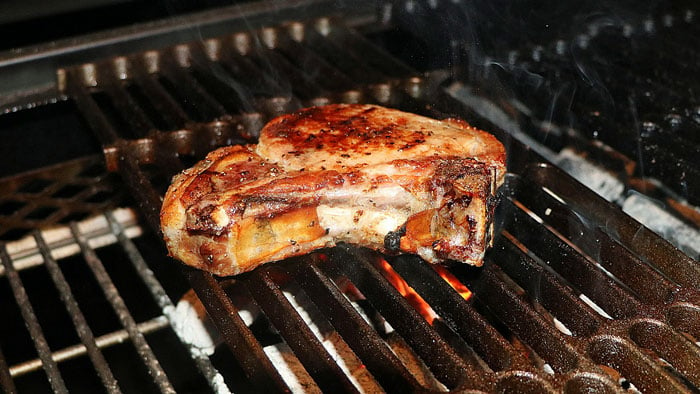
Credit: amazingribs.com
Mastering Smoking Techniques
To smoke a pork shoulder to perfection, you’ll need to combine the right temperature control with impeccable smoking techniques. These techniques are essential for infusing the meat with a smoky flavor while keeping it juicy and tender. Follow these steps to become a smoking maestro at your charcoal grill.
Maintaining Smoke Levels
Consistent smoke levels are critical for a perfectly smoked pork shoulder. Aim to keep the temperature steady between 225 and 250 degrees Fahrenheit. Here’s how to manage it:
- Use a thermometer to monitor the grill’s temperature.
- Adjust the air vents — open to increase heat, close to decrease.
- Check the coals every hour, adding more if needed.
- Stay vigilant; quick temperature spikes can hamper the smoking process.
Adding Wood Chips For Flavor
Wood chips contribute a distinguished flavor to your pork shoulder. Here’s how to enhance the taste:
- Choose wood chips that complement pork, such as hickory or applewood.
- Soak the wood chips for at least 30 minutes before using them.
- Add the soaked chips directly on the coals or use a smoker box to avoid flare-ups.
- Replenish wood chips periodically to maintain the flavor intensity.
By implementing these steps, your pork shoulder will boast a rich, smoky flavor that’s hard to resist. Grilling enthusiasts and dinner guests alike will savor the succulent results of your smoking expertise.
Monitoring The Cook
Smoking a pork shoulder to perfection demands patience and vigilance. Regular checks ensure even cooking and juicy results. Begin by setting yourself up for success; prep your grill to maintain a consistent temperature around 225-250 degrees Fahrenheit. Now let’s dive into the key steps for monitoring your pork shoulder’s journey to deliciousness.
Checking Internal Temperature
Keeping tabs on the meat’s internal temperature is vital. The aim is to reach a tender zone between 195 to 205 degrees Fahrenheit. Use a reliable digital meat thermometer—insert it into the thickest part of the shoulder. Do this without touching the bone, as it gives off heat and can misread the temp.
Remember: Open the lid sparingly to avoid heat escape.
- Check temperature every hour.
- Keep the lid closed as much as possible.
- Note any temperature changes.
Adjusting For Hot Spots
Charcoal grills can have hot and cool zones. It’s important to rotate the pork shoulder occasionally. This ensures an even cook. Pay attention to the grill’s surface temperature using a grill surface thermometer. Move the pork shoulder away from hotter areas if you notice one side browning too quickly.
| Action | Reason |
|---|---|
| Rotate meat | Even browning and doneness |
| Add coals | Maintain consistent heat |
Be sure to place coals to the sides, creating indirect heat. This reduces the chance of burning the meat. Monitor these conditions closely for the perfect smoke ring and a flavorful, melt-in-your-mouth experience.
Rest And Serve
After hours of smoking, the pork shoulder is almost at its peak flavor. The ‘Rest and Serve’ stage is crucial. It allows juices to be redistributed. It makes sure every slice is juicy and tender. Let’s dive into the proper resting time and tips for carving your masterpiece.
Proper Resting Time
Patience is key after taking the pork shoulder off the grill. It’s tempting to slice it right away, but that can lead to dry meat. Instead, follow these steps:
- Wrap the pork shoulder in foil to lock in the heat.
- Place it in a cooler or a turned-off oven. This keeps it warm.
- Let it rest for at least one hour. For larger cuts, aim for two hours.
- This resting period allows fibers to reabsorb the juices that have been bubbling at the surface.
Carving Like A Pro
Once the meat has rested, it’s time to slice. For the best experience:
- Use a sharp knife that can handle the tender meat.
- Find the grain of the meat and slice it against it. This makes each bite more tender.
- Cut thin slices for sandwiches or thicker pieces for plating.
Feel each slice fall apart with minimal effort. The pink smoke ring around the edge signifies a well-smoked shoulder.
Ready the sauce and fixings. It’s time to serve this smokey delight. Watch as faces light up with the first taste of your perfectly smoked and carved pork shoulder!
Common Pitfalls To Avoid
Smoking a pork shoulder on a charcoal grill promises delectable results. But there are traps along the way. Mastering the meat’s moisture and managing heat is crucial. Let’s steer clear of common missteps to ensure that smoky succulence.
Avoiding Dryness
A juicy pork shoulder is a crowd-pleaser. Dryness can ruin the experience. Maintain moisture with these simple tips:
- Marinate the meat for several hours to lock in flavor and juiciness.
- Use a water pan in your grill to maintain humidity.
- Mop or spritz the pork shoulder regularly with a flavorful liquid.
- Wrap in foil after the internal temperature reaches 150°F to preserve moisture.
- Rest the meat post-cook to ensure juices redistribute throughout the pork.
Controlling Flare-ups
Uncontrolled heat can spell disaster. Keep flare-ups in check with these tactics:
- Position your pork shoulder on the indirect heat zone of your grill to avoid direct flames.
- Trim excess fat to minimize oil drippings that can fuel flare-ups.
- Keep the lid closed to starve oxygen and reduce sudden bursts of flame.
- Have a water bottle handy to quell unexpected flare-ups.
- Monitor your grill temperature with a good-quality thermometer.
Side Dishes And Pairings
After mastering the art of smoking a succulent pork shoulder, the journey to a delightful feast does not end there. The perfect ensemble of side dishes and beverage pairings transforms a good meal into a great experience. Let’s explore the accompaniments that will complement the rich, smoky flavors of your charcoal-grilled pork shoulder.
Complementary Sides
Selecting the right sides ensures every bite is a symphony of flavors. Here are some top choices:
- Classic Coleslaw: A crunchy, creamy coleslaw balances the pork’s richness.
- Grilled Vegetables: Slightly charred seasonal veggies offer a fresh contrast.
- Cornbread: Sweet and buttery, it’s a soul-satisfying sidekick.
- Baked Beans: Their sweetness and texture are perfect partners.
- Macaroni and Cheese: Indulgent, creamy, and utterly delicious.
- Potato Salad: Pick a recipe with a tangy dressing to cut through the fat.
Beverage Suggestions
No meal is complete without the right beverage:
| Beverage Type | Suggested Option |
|---|---|
| Beer | A smooth lager or a pale ale complements the smoke. |
| Wine | Opt for a fruity Zinfandel or a bold Shiraz. |
| Whiskey | A bourbon with sweet notes highlights the meat’s flavor. |
| Non-Alcoholic | Try a sparkling apple cider or a homemade lemonade. |
Cleanup And Grill Maintenance
Cleanup and Grill Maintenance is essential after smoking a savory pork shoulder to ensure your charcoal grill remains in top condition for your next barbecue session. Proper post-cook cleaning prevents buildup. Regular maintenance helps your grill last longer. Let’s dive into the best practices for keeping your grill pristine.
Post-cook Cleaning
Once the smoked pork shoulder has delighted your taste buds, it’s time to address the grill. Begin when the grill cools but is still warm to the touch. This makes it easier to scrub off food particles and grease.
- Empty the Ashes: Discard ashes from the charcoal grate. Ashes collect moisture, leading to rust.
- Scrub the Grates: Use a grill brush on the grates. Remove any stuck-on meat or residues.
- Wipe Surfaces: Clean the grill’s interior with a damp cloth. Target grease spots.
- Check the Drip Pan: If your grill has one, empty and wash the drip pan thoroughly.
Dispose of waste responsibly. Ensure all components dry completely to avoid rust.
Maintaining Your Grill For The Next Smokeout
Maintaining your grill extends its life and improves future smoke flavors. Below are key habits to adopt:
- Inspect Components: Regularly check for wear and tear. Replace parts as needed.
- Oil the Grates: Before and after grilling, oil the grates. This keeps them non-stick and rust-free.
- Protect Your Grill: Use a grill cover when not in use. Shields from weather damage.
- Season Your Grill: Coat the interior with cooking oil and heat the grill for around 30 minutes.
Consistent upkeep guarantees your charcoal grill is always ready for a smoky feast!
Learning From The Pitmasters
Grilling enthusiasts often turn to expert pitmasters for secrets in smoking meats to perfection. Smoking a pork shoulder on a charcoal grill is an art that combines patience and skill. Pitmasters have honed this art with years of practice and experimentation. By understanding their methods, you can elevate your grilling game and deliver mouth-watering smoked pork shoulder to your table.
Taking Inspiration
Pitmasters inspire us with their unwavering dedication to the craft of smoking meats. They use tried-and-true methods that result in succulent flavors. By scrutinizing their strategies, you can apply the same principles to your charcoal grill. Observe their techniques, from the way they maintain consistent temperatures to how they select wood for smoking. Use these observations to successfully smoke your pork shoulder.
- Watch video tutorials from known pitmasters
- Read cookbooks and articles featuring expert grillers
- Attend BBQ competitions or workshops
Expanding Your Smoking Technique Repertoire
After drawing inspiration from the pros, it’s time to practice and expand your own smoking techniques. With a charcoal grill, mastering temperature control and smoke management is essential. Learn different ways to set up your grill for indirect smoking and how to use water pans for moisture.
Understanding the right time to wrap your pork shoulder in foil can also make a world of difference. Each technique has a specific purpose, be it enhancing juiciness or developing a rich bark.
| Technique | Purpose | Tools Needed |
|---|---|---|
| Indirect Smoking | Even cooking without direct flames | Charcoal, Wood chips |
| Using a Water Pan | Adds moisture to tender meat | Water pan, Water |
| Foil Wrapping | Locks in juices for the final cooking stage | Aluminum foil |
Gather insights from the pitmasters, then practice diligently. Your efforts will pay off when your pork shoulder becomes the star of your next barbecue session.
Pitmaster’s Tips And Tricks
Welcome to the ‘Pitmaster’s Tips and Tricks’ for smoking a pork shoulder on a charcoal grill. This is where magic happens with a combination of patience, expertise, and the right techniques. Get ready to elevate your barbecuing skills with insider advice straight from the pros.
Expert Tricks
Successful pitmasters follow specific strategies to smoke pork shoulder to perfection. Here are bulletproof tricks to keep up your sleeve:
- Maintain steady temperatures between 225°F and 250°F.
- Use a water pan to keep the moisture level consistent.
- Check the pork shoulder’s internal temperature with a reliable meat thermometer.
- Mix hardwood such as oak or hickory with charcoal for a smoky flavor.
- Allow the meat to rest for at least an hour before serving.
Resource Recommendations
Having the right tools and materials makes the process smoother. Consider these essentials:
| Item | Reason | Tip |
|---|---|---|
| Charcoal Chimney Starter | For even heat | Fill with briquettes for a consistent burn |
| Meat Thermometer | To check doneness | Insert in the thickest part, avoiding bone |
| Grill Gloves | Safety first | Choose heat-resistant materials |
| Wood Chips | For smoke flavor | Soak in water before use to prevent burning |
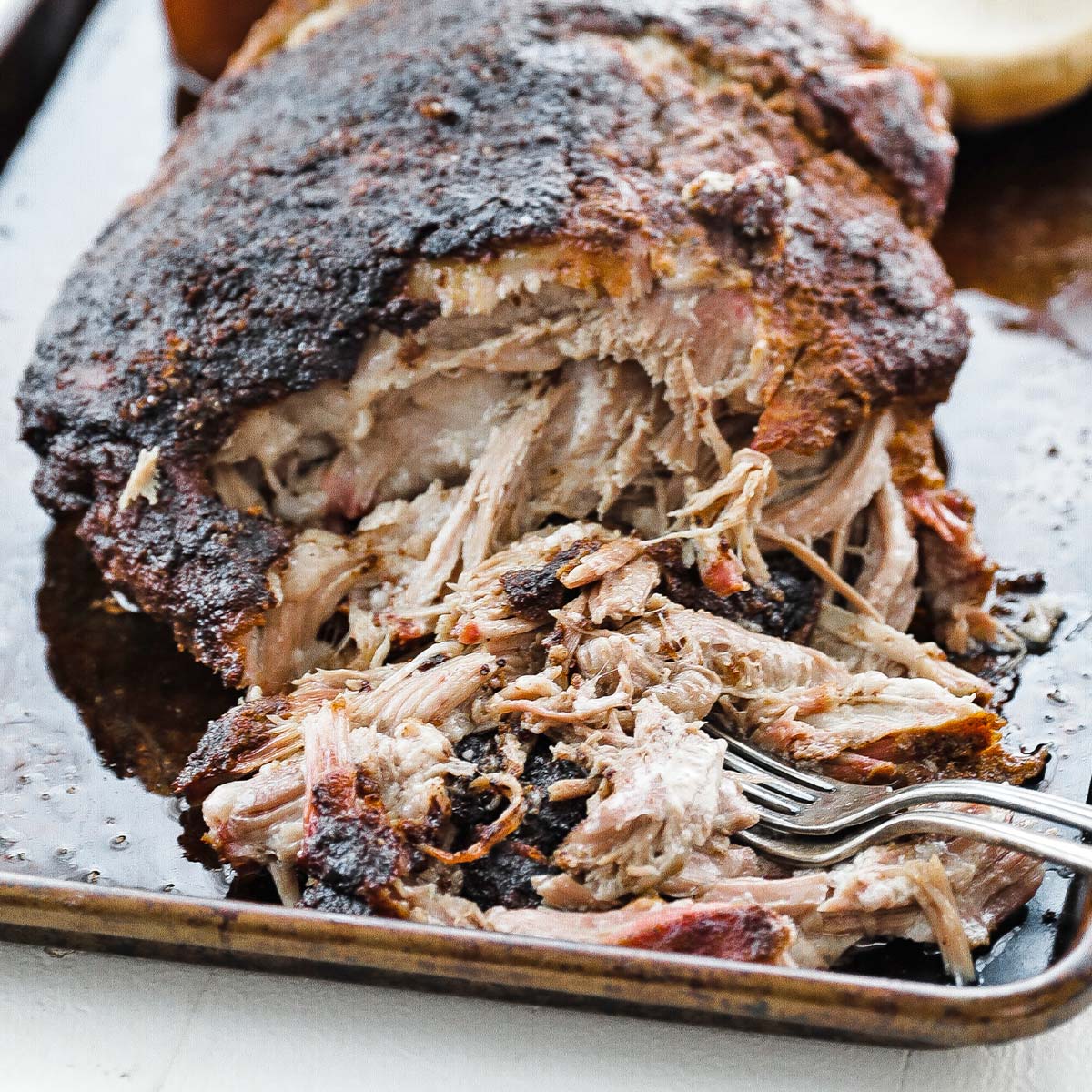
Credit: www.billyparisi.com
Frequently Asked Questions On How To Smoke A Pork Shoulder On A Charcoal Grill
What’s The Best Temperature For Smoking Pork Shoulder?
Maintaining a consistent temperature between 225°F and 250°F is ideal for smoking pork shoulder to achieve tender, flavorful results.
How Long To Smoke Pork Shoulder On Charcoal Grill?
Pork shoulder should be smoked until it reaches an internal temperature of 195°F to 205°F, which typically takes about 1 to 1. 5 hours per pound.
Can I Smoke Pork Shoulder Without Wrapping?
Yes, you can smoke a pork shoulder without wrapping it, which may lead to a darker and more pronounced bark on the exterior of the meat.
Conclusion
Smoking a pork shoulder on a charcoal grill offers a delightful feast. With patience and careful temperature control, you’ll master the art. Embrace the process and enjoy succulent, smoky flavors. Ready your grill, savor the journey, and share an unforgettable meal with loved ones.
Happy grilling!
